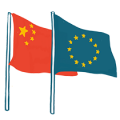

The EU’s new connectivity agenda
What (not) to learn from the Belt and Road Initiative?
The Council of the European Union recently approved conclusions on “A Globally Connected Europe.” The adoption of this policy document is the latest milestone in an ongoing European attempt to orchestrate a new connectivity strategy, partly in response to China’s Belt and Road Initiative (BRI).
In 2018, an EU joint communication on “Connecting Europe and Asia” was released, establishing the building blocks for a “sustainable, comprehensive and rules-based” connectivity strategy. Over the past year, the topic of connectivity has picked up steam, with European Parliament urging a global connectivity strategy, the adoption of an EU Indo-Pacific strategy with connectivity elements and G7 discussions about a new “build back better world” initiative.
Although the Council conclusions themselves make no reference to China, competition with China provides the context for a renewed connectivity agenda. Implicit in the calls for a new strategy is the acknowledgement that China is doing something through the BRI that warrants a course adjustment from the EU.
The EU is not new to the connectivity game – but it has an image problem
The EU, which is home to world’s largest multilateral development bank (the European Investment Bank), has been building connective infrastructure across the world for decades According to data from the European External Action Service, EU development assistance between 2013 and 2018 stood at EUR 414 billion, slightly lower than EUR 434 billion of Chinese financing for BRI projects. A bigger difference between these two figures is that the EU money came in grant form, while China extended theirs as loans.
The Council’s conclusions acknowledge that despite this economic reality, the EU is failing to reap the reputational rewards of its connectivity work. One of the several steps recommended by the Council conclusions to address this is to “ensure the visibility of the EU’s global connectivity actions through coherent strategic communication in a Team Europe approach.” The conclusions envisage a “unifying narrative” as well as a “recognizable brand name and logo.”
But the BRI’s appeal transcends branding, and its narrative success owes much to domestic and regional politics of host countries. In Serbia for instance, a pro-China agenda serves the political ambitions of the Serbian president – it is the Serbian media rather than the Chinese which is responsible for the BRI’s visibility.
The EU needs to cut red tape and make applications for financing easier
The relative convenience of Chinese finance is another part of the BRI’s appeal to host countries. Compared to EU funding, the BRI package comes with less red tape.
Although suboptimal in terms of market considerations, the tying of Chinese engineering contracts to state finance, which largely facilitates BRI, is sometimes more accessible for governments with limited resources. The application for Chinese finance for projects executed by companies with links to the party state is more of a political than bureaucratic process, relying on interpersonal ties and access to the Chinese embassy rather than administrative capacity.
The recommendation of the Council conclusions to “present coherent and streamlined financing schemes” may help address this problem. The establishment of the “Global Europe” fund, which unifies several EU external action instruments, appears to be a step in the right direction. However, the EU should be careful to make sure that such efforts go beyond branding and bureaucratic re-organization. It can ensure this by cutting red tape and making application processes clearer for recipient countries.
Regarding increasing accessibility of funds, the Council recommends mobilizing “the private sector to finance and implement projects.” Yet, persuading private investors to put capital into low short-term yield, high-risk infrastructure projects is the holy grail of development finance. The problem is a lack of bankable infrastructure projects, leading to a decline of private investment in developing country infrastructure by 36 percent over the past 10 years. The calls repeated in the Council conclusions for a “Business Advisory Group” for private-public consultation and coordination on projects is certainly an important step in this process.
BRI-style hard infrastructure projects are appealing for local elites
BRI also appeals to host countries because it facilitates often large-scale hard infrastructure projects that are unable to attract financing from status-quo international financial institutions because they are deemed too risky or otherwise unsustainable. For example, the Chinese financed controversial highway in Montenegro was first turned down by the European Bank for Reconstruction and Development as commercially unviable.
Such projects are attractive to local elites because they are deemed necessary long-term investments for economic development, and/or because they provide kickbacks and political capital. A big bridge simply provides a better photo opportunity for the campaign trail than a cluster of small EU grants for private enterprise. If the EU were to put itself more often in the shoes of local elites and appreciate their political considerations, it could increase the appeal and impact of its connectivity schemes.
The Council conclusions call on the commission to “identify and implement a set of high impact and visible projects” as part of the new connectivity strategy, thus acknowledging a need for more physical infrastructure.
BRI’s successes and failures could inspire the EU
Just as the EU is gearing up to compete with BRI on the assumption of its success in creating economic leverage and generating political influence, there is evidence to suggest that the BRI as we know it – big loans for infrastructure projects – is in retreat. Although the specifics are contested, anecdotal evidence and data from Boston University show that policy bank loans from China peaked as early as 2016 and have been declining since.
Although it is often thought of in terms of strategic economic corridors, the reality of the BRI is that projects are rarely planned with network effects in mind. By deploying its expertise in connectivity and planning economic corridors that further EU strategic interests, the EU could achieve what the BRI set out but failed to do.
Framing the new connectivity strategy as a competition with China may be unnecessary. Neither does the EU need to ape the BRI. Instead, it should embark on its course correction taking BRI’s successes and failures as inspiration.
Read more:
- Council of the European Union: Council conclusions – A globally connected Europe
- European Parliament: Resolution on connectivity and EU-Asia relations
- Council of the European Union: Global Europe: final green light for the new financial instrument to support the EU's external action
- Rhodium Group: China’s Belt and Road: Down but not Out
- MERICS: Competing with China's Belt and Road Initiative
You are reading an excerpt of our latest MERICS Europe China 360°.
You can subscribe to this publication on an individual basis. For more information on our packages, click here.
MERICS members also have privileged access to this product. If you want to learn more about our membership model for institutions and businesses, please click here.
If you are a MERICS member, you can access the full publication here.


